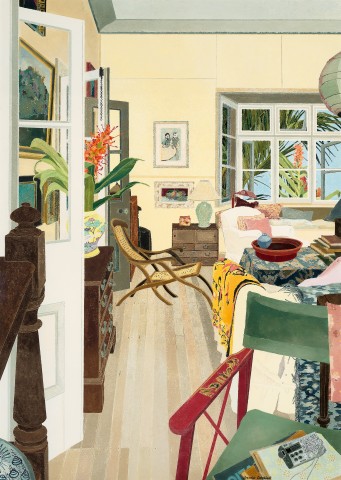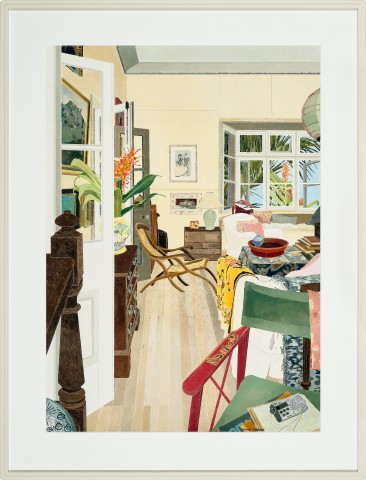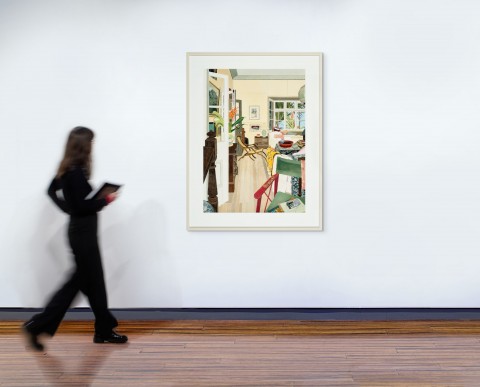INTERIOR WITH RED GINGER, 1998
CRESSIDA CAMPBELL
unique colour woodblock print
119.0 x 84.5 cm
signed lower right: Cressida Campbell
signed below image lower right: Cressida Campbell
Rex Irwin Art Dealer, Sydney
Private collection, Sydney, acquired from the above in 1999
Cressida Campbell, Rex Irwin Art Dealer, Sydney, 13 July – 7 August 1999, cat. 2
Crayford, P., (ed.), The Woodblock Painting of Cressida Campbell, Public Pictures Pty Ltd, Sydney, 2010 (3rd ed.), cat. P0306, pp. 231 (woodblock illustrated), 357
Cressida Campbell, through decades of unwavering commitment to a unique, detailed, and labour intensive artistic medium, has recently risen to new heights of critical and public acclaim. Her recent survey exhibition at the National Gallery of Australia is said to have broken attendance records and further cemented her position as a household name. Working at the intersection of printmaking and painting, Campbell conjures mirrored pairs of serene images, their prosaic subject matter often concealing the artist’s considered orchestration. These works, painted and incised woodblocks and printed on paper, are testaments to Campbell’s sophisticated visual intelligence and humble appreciation for the small wonders in her immediate physical environs. At the turn of the 20th century German philosopher and cultural critic Walter Benjamin theorised the domestic interior as a refuge of the collector, ‘not just the universe but also the étui (ornamental case) of the private individual. To dwell means to leave traces’.1
This sun-drenched and softly mottled woodblock print, Interior with Red Ginger, 1998 displays an interior view of the airy seaside home of the artist’s friend Lynne Clarke (née Drysdale) in Newport. Campbell elaborated on the influence of this friendship in an audio recording for the National Gallery exhibition: ‘[she is] one of my oldest friends and she's been a huge influence to me in interiors and gardens and the way she places things. [...] She'll arrange plants amazingly, [an] incredible gardener. [..] I mean it's brilliant interior design really.’2 The arrangement of contrasting textural details; of tropical floral combs with shiny broad leaves, white linen couches strewn with soft blankets, worn blond floorboards and discarded camcorder in the foreground alludes to an insouciant holiday atmosphere, with the room perhaps only recently vacated by its bare-footed inhabitants.
Compositionally daring, the artist’s domestic interiors present a feast for the eyes, demonstrating her broad engagement with her personal domestic realm, both at home and in temporary pied-à-terres. In a similar vein to the French intimist painters of the late 19th century, Campbell’s works often start with interstitial spaces (corridors, windows, alcoves) and from this entry point present a combination of several genres: still life in the foreground, moving into a deep view of a room, and finally culminating in a sliver of a landscape glimpsed through a window or open balcony door. Long before Campbell overtly described this process in the title of a work (Journey Around My Room, 2019), her interiors gently coaxed viewers to travel through time and space, living vicariously through the artist and her personal recollections, both known and imagined.
It is clear that Campbell is a pure aesthete. Her works are sublime, carrying no socio-political impetus, nor aiming to surprise or shock viewers. She delights in the form and colour of everyday objects, translating and manipulating them into artworks that express the enduring appeal of quiet tranquillity. Although singled out in the title of this print as the key identifying feature of this interior, the spiky cylindrical clusters of the Ginger Lily are partly obscured in the left-hand side of the image. They are placed within a complex intersection of angular planes and panes of glass, between framed artworks on the wall and French doors opening presumably to a verandah out of view. While the dark timber balustrade anchors the composition in the left-hand corner, the whitewashed window frames of the bay windows in the upper right reveal a brilliant blue sky, with palm fronds and a second ginger blossom, connecting the interior with the world beyond. Here Campbell is at the height of her technical proficiency, delighting in the intellectual game of representing pictures in pictures, using a printing process that itself requires a mastery of reflected images.
1. Benjamin, W., The Work of Art in the Age of Technological Reproducibility and other Writings on Media, Harvard University Press, Cambridge, 2008, p. 104
2. The artist, 2022 at https://nga.gov.au/tours/cressida-campbell/stop/123/ (accessed September 2023)
LUCIE REEVES-SMITH


